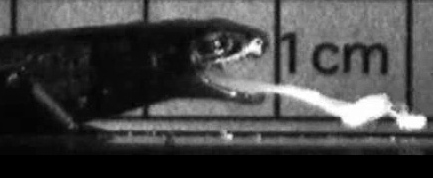
The giant palm salamander of Central America shoots out its tongue with more instantaneous power than any known muscle in the animal kingdom, a new study finds.
The salamander, Bolitoglossa dofleini, can shoot out its tongue with 18,000 watts of power per kilogram of muscle. This is nearly double the power output of the previous champ, the Colorado River toad Bufo alvarius.
Bolitoglossa can extend its tongue more than half its body length in about 7 milliseconds, or about 50 times faster than an average eye blink.
- Video: Salamander catching a cricket
Stephen Deban of the University of South Florida and his colleagues used high-speed video cameras and electrodes implanted in the salamanders’ tongue muscles to monitor the animals as they launched at live crickets.
The findings revealed the tongues were propelled outward [image] much faster than could be achieved by muscle contraction alone.
The researchers think that still unidentified elastic tissue attached to the salamander’s tongue stores up energy in preparation for an explosive action.
Deban likens the process to stretching and shooting a rubber band: the recoil occurs faster than the act of releasing a rubber band pulled taut.
Get the world’s most fascinating discoveries delivered straight to your inbox.
“The amount of energy doesn’t change; it’s just released faster,” Deban told LiveScience.
How the salamander achieves its record power output is still unclear. Tongue-launching systems in other animals require three components: a motor to generate energy, a spring to store the energy and a latch to control the timing of unloading of the spring. Scientists have so far identified only the motor in the salamander system.
“What remains to be discovered are the anatomical structures that make up the spring and the latch,” the researchers write in the Feb. 15 issue of the Journal of Experimental Biology.


